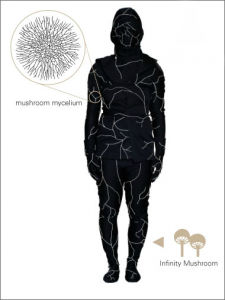Would You Let Mushrooms Eat Your Body after Death?
 The mushroom burial suit prototype (image via Coeio)
The mushroom burial suit prototype (image via Coeio) Most of us don’t like to ponder our own death or the nothingness of nonexistence, but for those who’ve already gotten past the question of what happens after we die, Jae Rhim Lee and Mike Ma answer the next important question: “How can my death have the least adverse environmental impact?”
Lee and Ma are the inventors of the “mushroom death suit,” which they’ve branded as an “infinity burial product” offered by their start-up Coeio. This bodysuit is made of a network of mushroom spores that feed on the human body after death, detoxifying the body as it decomposes.
The suit, which garnered interest with Lee’s popular 2011 TED talk about the prototype, is now ready and will hit the market later this year. At $999, the suit carries a relatively low price tag compared to the thousands that can be spent on a traditional funeral.
Traditional burial services use formaldehyde, fillers, and cosmetics to preserve the body, all of which can impact the health of morticians and funeral service workers. Traditional burial also requires substantial space and resources (steel and wood for caskets, cement for burial vaults).
“We are both responsible for and the victims of our own pollution,” Lee notes in her TED talk. “Our bodies are filters and storehouses for environmental toxins.” According to the United Nations, cremation produces 0.2 percent of global dioxin and furan emissions.
Certainly Coeio isn’t the first to offer a green burial option, and many creative, environmentally friendly, or simply nontraditional options exist. (See “A Green Hereafter” from the July/August 2014 issue of the Humanist on the growing popularity of eco-funerals.) Want to compress your ashes, for example, into a diamond or “LifeGem”? How about using cremated remains to create artificial reef formations that act as new marine habitat? And there other uses of cremated ashes that offer one a legacy after death.
Still, few options offer toxin remediation like the mushroom death suit does. Swedish company Promessa Organic AB uses freeze-drying of the corpse in liquid nitrogen to make the body disintegrate more easily, then uses magnets to remove heavy metal toxins before burying remains in a biodegradable casket in a shallow grave. Another interesting idea is Capsula Mundi, an Italian start-up that aims to grow trees from human bodies. Bodies or ashes fit into biodegradable burial pods and act as nutrients for the tree, chosen by the deceased, that is planted on top. Instead of cemeteries with grave markers, they envision the creation of “memory forests.”
Most interesting, though, is Lee’s philosophy behind the mushroom suit: “See for me, cultivating the Infinity Mushroom is more than just scientific experimentation or gardening or raising a pet, it’s a step towards accepting the fact that someday I will die and decay. It’s also a step towards taking responsibility for my own burden on the planet.”
This fits into her conceptualization of “decompiculture” (the cultivation of decomposing organisms), a term first coined by University of Toronto entomologist Timothy Myles. Says Lee:
[We] share a common desire to understand and accept death and to minimize the impact of our death on the environment. I wanted to cultivate this perspective just like the mushrooms, so I formed the Decompiculture Society, a group of people called decompinauts who actively explore their postmortem options, seek death acceptance, and cultivate decomposing organisms like the Infinity Mushroom. The Decompiculture Society shares a vision of a cultural shift, from our current culture of death denial and body preservation to one of decompiculture, a radical acceptance of death and decomposition.
It all sounds rather morbid, yet I think humanists can appreciate the beauty of crafting a legacy that softens our impact on the earth and its environment. “Accepting death means accepting that we are physical beings who are intimately connected to the environment,” Lee says, citing the research on environmental toxins and concluding:
Once we understand that we’re connected to the environment, we see that the survival of our species depends on the survival of the planet. I believe this is the beginning of true environmental responsibility.
